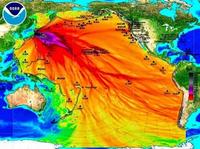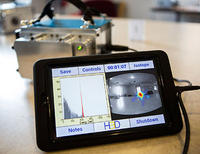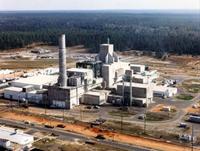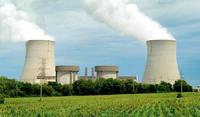-
Budget proposal cuts funds for nuclear nonproliferation programs
The White House’s fiscal 2015 budget proposal includes more than $220 million in cuts for nuclear security initiatives such as the International Material Protection and Cooperationprogram, which aims to secure and eliminate vulnerable nuclear weapons and materials, and the Global Threat Reduction Initiative, which supports the Energy Department’s efforts to prevent terrorists from acquiring nuclear and radiological materials that could be used in weapons of mass destruction. The administration says that 54 percent of the reduction in the administration’s nonproliferation budget request can be accounted for by the decision to halt the South Carolina Mixed Oxide Fuel Fabrication Facility(MOX), which would have convert weapons-grade plutonium into nuclear reactor fuel, because the project proved to be too costly.
-
-
Radiation from Fukushima to reach West Coast in April

On the third anniversary of the Fukushima nuclear plant incident, scientists are reporting that low levels of radiation from the Fukushima plant will reach ocean waters along the U.S. West Coast by April 2014. The scientists say that the radiation will be at levels too low to harm humans, but they call for more monitoring, including at the federal level.
-
-
Innovative nuclear radiation detector reaches the market

A handheld radiation camera developed by University of Michigan engineering researchers offers nuclear plant operators a faster way to find potentially dangerous hot spots and leaky fuel rods. The new Polaris-H detector lays a gamma-ray map over an image of a room, pinpointing radiation sources with unprecedented precision. At least four U.S. nuclear power plants are using versions of the camera, which is now available commercially through the U-M spinoff company H3D.
-
-
Underground recovery process at WIPP begins
Nuclear Waste Partnership (NWP), the management and operations contractor at the Waste Isolation Pilot Plant (WIPP) for the U.S. Department of Energy (DOE), said it has initiated the first phase of an underground recovery process which will lead to the resumption of nuclear waste disposal operations at WIPP. Initial results show no airborne radioactive contamination in the underground shafts.
-
-
Virtual lab for nuclear waste repository research
A nuclear waste repository must seal in radioactive waste safely for one million years. Researchers currently have to study repositories and their processes in real underground laboratories, but a virtual underground laboratory will soon simplify their work.
-
-
Energy Department suspends work on controversial plutonium reprocessing project

The Obama administration has decided to put on hold its plans to complete construction on a South Carolina reprocessing facility which would convert nuclear weapon-grade plutonium into reactor fuel. The suspension of work on the project is part of the fiscal 2015 budget plan the administration unveiled Tuesday. The project has been hobbled by delays and massive cost-overruns, and experts says security and safety concerns have not been adequately addressed.
-
-
Operator set to close three Illinois nuclear power plants

Abundant natural gas and growing reliance on solar and wind energy have been steadily eroding the profit margins of nuclear energy. Last year operators have shut down four nuclear plants in the United States last year. Exelon Corporation, which operates six nuclear plants in Illinois, has notified Illinois state regulators that legislative actions may be necessary to keep half of its Illinois nuclear plants from closing, since current market forces make it impossible to continue the operation of the plants profitably.
-
-
Employees exposed to radiation at nuclear waste disposal site
Thirteen employees at the Waste Isolation Pilot Plant(WIPP),a nuclear waste burial site in New Mexico, have been exposed to radioactive radiation after a leak in one of WIPP’s underground tunnels. Energy Department officials say it is too soon to determine the scope of health risks the employees will deal with. The employees inhaled plutonium and americium, both of which can irradiate the body’s internal organs with subatomic particles for a lifetime.
-
-
Operator of Hanford nuclear disposal site fires scientists who voice safety concerns
The Hanford project in Washington State is the Department of Energy’s (DoE) largest nuclear cleanup project. DoE plans to transform fifty-six million gallons of radioactive sludge, currently stored in underground tanks, into solid glass. Scientists and engineers who work at Hanford have questioned the effectiveness of the required technology, and have voiced serious concerns about safety issues. Two of those who were the most persistent in voicing their concerns about safety have been fired, and a third one has left his job voluntarily.
-
-
Security of dirty bomb materials in U.S. inadequate: experts
There are more than 5,000 medical and research devices in the United States containing high-activity radiation sources, including 700 with category-1 sources. Category-1 radiation material could be used by terrorists in dirty bombs. The security measures developed by the industry were written with accident prevention in mind, not in order to thwart a deliberate, forcible effort by terrorists or criminals to gain control of the toxic material. In addition, radioactive materials were considered to be “self-protecting,” because it was assumed that the powerful radiation would deter anyone thinking of tampering with these devices. Terrorist bomb-makers, however, showed themselves to be more technologically-savvy than earlier thought, and, in any event, suicide bombers would not be deterred by the risk of radiation poisoning.
-
-
U.S. Navy probes exam cheating at school for nuclear power reactor operator
Yet another military service is facing allegations of exam-cheating. Earlier this year, the U.S. Air Force launched a probe into a cheating scandal involving about 100 officersat Malmstrom Air Force Base, Montana, who are responsible for maintaining and operating land-based nuclear missiles. Now the U.S. Navy is investigating about one-fifth of its trainers at the school for naval nuclear power reactor operators in Charleston, South Carolina. The sailors are accused of cheating on written tests required to obtain certification as instructors at the nuclear propulsion school.
-
-
Service lives of European nuclear power stations to be extended
Germany has decided to abandon nuclear energy – in what the Germans call Energiewende (energy turnaround) – but new nuclear power stations are being built on all sides of Germany and service lives for existing facilities on the territory of Germany’s neighbors are being extended. German nuclear scientists should thus continue to be involved in assessing the safety of the nuclear power stations in neighboring countries, especially so since the EU has launched its LONGLIFE project, which aims to extend the service life of existing reactors from forty to sixty or even eighty years.
-
-
NRC: storing spent nuclear fuel in cooling pools is safe
The nuclear reactors now in service in the United States were built with the assumption that the spent fuel would be removed from nuclear the facilities after a few years, but because the government has failed to provide a centralized place to store the spent fuel, utility companies have had to store an ever-growing quantity of it in spent fuel pools on the grounds of the facilities. Scientists argue that it would be safer to move some of the spent fuel into giant steel and concrete casks, where it can be stored dry, with no reliance on water, pumps, or filters to keep them cool. The nuclear industry and the NRC do not agree.
-
-
Nations' nuclear ambitions not discouraged by few suppliers
Twenty-nine countries are considering constructing their first nuclear power plant. There are doubts as to which of these nuclear “newcomer” countries can actually succeed and join the thirty-one countries that already operate nuclear reactors. If even half of the national plans for nuclear power plants materialize, the geography of nuclear energy would radically change and could revitalize a stagnant industry. But given the obstacles to starting a national nuclear power program even for rich and stable countries, it’s not likely to happen quickly elsewhere.
-
-
One step closer to nuclear fusion power station
Researchers have made a technological breakthrough crucial to the success of nuclear fusion reactors, allowing for clean, inexhaustible energy generation based on the workings of the stars in our galaxy. At the heart of the new development is an ingenious and robust superconducting cable system. This makes for a remarkably strong magnetic field that controls the very hot, energy-generating plasma in the reactor core, laying the foundation for nuclear fusion. The new cables are far less susceptible to heating due to a clever way of interweaving, which allows for a significant increase in the possibilities to control the plasma.
-
More headlines
The long view
Smaller Nuclear Reactors Spark Renewed Interest in a Once-Shunned Energy Source
In the past two years, half the states have taken action to promote nuclear power, from creating nuclear task forces to integrating nuclear into long-term energy plans.
Keeping the Lights on with Nuclear Waste: Radiochemistry Transforms Nuclear Waste into Strategic Materials
How UNLV radiochemistry is pioneering the future of energy in the Southwest by salvaging strategic materials from nuclear dumps –and making it safe.
Model Predicts Long-Term Effects of Nuclear Waste on Underground Disposal Systems
The simulations matched results from an underground lab experiment in Switzerland, suggesting modeling could be used to validate the safety of nuclear disposal sites.
